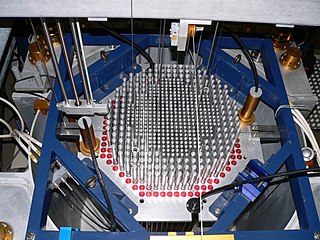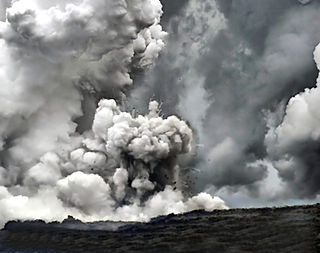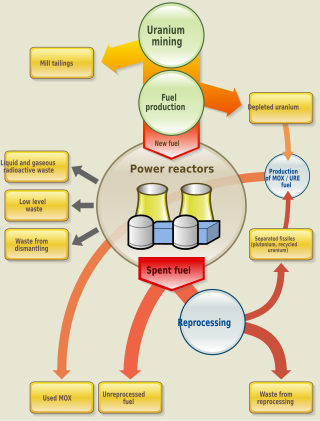MELCOR is a fully integrated, engineering-level computer code developed by Sandia National Laboratories for the U.S. Nuclear Regulatory Commission to model the progression of severe accidents in nuclear power plants. A broad spectrum of severe accident phenomena in both boiling and pressurized water reactors is treated in MELCOR in a unified framework. MELCOR applications include estimation of severe accident source terms, and their sensitivities and uncertainties in a variety of applications.

A nuclear reactor is a device used to initiate and control a fission nuclear chain reaction or nuclear fusion reactions. Nuclear reactors are used at nuclear power plants for electricity generation and in nuclear marine propulsion. Heat from nuclear fission is passed to a working fluid, which in turn runs through steam turbines. These either drive a ship's propellers or turn electrical generators' shafts. Nuclear generated steam in principle can be used for industrial process heat or for district heating. Some reactors are used to produce isotopes for medical and industrial use, or for production of weapons-grade plutonium. As of 2022, the International Atomic Energy Agency reports there are 422 nuclear power reactors and 223 nuclear research reactors in operation around the world.

K-19 was the first submarine of the Project 658 class, the first generation of Soviet nuclear submarines equipped with nuclear ballistic missiles, specifically the R-13 SLBM. The boat was hastily built by the Soviets in response to United States' developments in nuclear submarines as part of the arms race. Before she was launched, 10 civilian workers and a sailor died due to accidents and fires. After K-19 was commissioned, the boat had multiple breakdowns and accidents, several of which threatened to sink the submarine.

A pressurized water reactor (PWR) is a type of light-water nuclear reactor. PWRs constitute the large majority of the world's nuclear power plants. In a PWR, the primary coolant (water) is pumped under high pressure to the reactor core where it is heated by the energy released by the fission of atoms. The heated, high pressure water then flows to a steam generator, where it transfers its thermal energy to lower pressure water of a secondary system where steam is generated. The steam then drives turbines, which spin an electric generator. In contrast to a boiling water reactor (BWR), pressure in the primary coolant loop prevents the water from boiling within the reactor. All light-water reactors use ordinary water as both coolant and neutron moderator. Most use anywhere from two to four vertically mounted steam generators; VVER reactors use horizontal steam generators.

A nuclear meltdown is a severe nuclear reactor accident that results in core damage from overheating. The term nuclear meltdown is not officially defined by the International Atomic Energy Agency or by the United States Nuclear Regulatory Commission. It has been defined to mean the accidental melting of the core of a nuclear reactor, however, and is in common usage a reference to the core's either complete or partial collapse.

A safety-critical system (SCS) or life-critical system is a system whose failure or malfunction may result in one of the following outcomes:

A loss-of-coolant accident (LOCA) is a mode of failure for a nuclear reactor; if not managed effectively, the results of a LOCA could result in reactor core damage. Each nuclear plant's emergency core cooling system (ECCS) exists specifically to deal with a LOCA.

Idaho National Laboratory (INL) is one of the national laboratories of the United States Department of Energy and is managed by the Battelle Energy Alliance. While the laboratory does other research, historically it has been involved with nuclear research. Much of current knowledge about how nuclear reactors behave and misbehave was discovered at what is now Idaho National Laboratory. John Grossenbacher, former INL director, said, "The history of nuclear energy for peaceful application has principally been written in Idaho".

A steam explosion is an explosion caused by violent boiling or flashing of water or ice into steam, occurring when water or ice is either superheated, rapidly heated by fine hot debris produced within it, or heated by the interaction of molten metals. Pressure vessels, such as pressurized water (nuclear) reactors, that operate above atmospheric pressure can also provide the conditions for a steam explosion. The water changes from a solid or liquid to a gas with extreme speed, increasing dramatically in volume. A steam explosion sprays steam and boiling-hot water and the hot medium that heated it in all directions, creating a danger of scalding and burning.

Nuclear fuel is material used in nuclear power stations to produce heat to power turbines. Heat is created when nuclear fuel undergoes nuclear fission.
Generation IV reactors are nuclear reactor design technologies that are envisioned as successors of generation III reactors. The Generation IV International Forum (GIF) - an international organization that coordinates the development of generation IV reactors - specifically selected six reactor technologies as candidates for generation IV reactors. The designs target improved safety, sustainability, efficiency, and cost. The first commercial Gen IV plants are not expected before 2040–2050, although the World Nuclear Association in 2015 suggested that some might enter commercial operation before 2030.
CRAC-II is both a computer code and the 1982 report of the simulation results performed by Sandia National Laboratories for the Nuclear Regulatory Commission. The report is sometimes referred to as the CRAC-II report because it is the computer program used in the calculations, but the report is also known as the 1982 Sandia Siting Study or as NUREG/CR-2239. The computer program MACCS2 has since replaced CRAC-II for the consequences of radioactive release.

The Economic Simplified Boiling Water Reactor (ESBWR) is a passively safe generation III+ reactor design derived from its predecessor, the Simplified Boiling Water Reactor (SBWR) and from the Advanced Boiling Water Reactor (ABWR). All are designs by GE Hitachi Nuclear Energy (GEH), and are based on previous Boiling Water Reactor designs.

In the United States, nuclear power is provided by 92 commercial reactors with a net capacity of 94.7 gigawatts (GW), with 61 pressurized water reactors and 31 boiling water reactors. In 2019, they produced a total of 809.41 terawatt-hours of electricity, which accounted for 20% of the nation's total electric energy generation. In 2018, nuclear comprised nearly 50 percent of US emission-free energy generation.

Carolinas–Virginia Tube Reactor (CVTR), also known as Parr Nuclear Station, was an experimental pressurized tube heavy water nuclear power reactor at Parr, South Carolina in Fairfield County. It was built and operated by the Carolinas Virginia Nuclear Power Associates. CVTR was a small test reactor, capable of generating 17 megawatts of electricity. It was officially commissioned in December 1963 and left service in January 1967.
The following outline is provided as an overview of and topical guide to nuclear technology:
Core damage frequency (CDF) is a term used in probabilistic risk assessment (PRA) that indicates the likelihood of an accident that would cause severe damage to a nuclear fuel in a nuclear reactor core. Core damage accidents are considered extremely serious because severe damage to the fuel in the core prevents adequate heat removal or even safe shutdown, which can lead to a nuclear meltdown. Some sources on CDF consider core damage and core meltdown to be the same thing, and different methods of measurement are used between industries and nations, so the primary value of the CDF number is in managing the risk of core accidents within a system and not necessarily to provide large-scale statistics.
The Office of Nuclear Reactor Regulation, is a subordinate part of the United States Nuclear Regulatory Commission.
The VVER-TOI or WWER-TOI is a generation III+ nuclear power reactor based on VVER technology developed by Rosatom. The VVER-TOI design is intended to improve the competitiveness of Russian VVER technology in international markets. It would use VVER-1300/510 water pressurized reactors constructed to meet modern nuclear and radiation safety requirements.